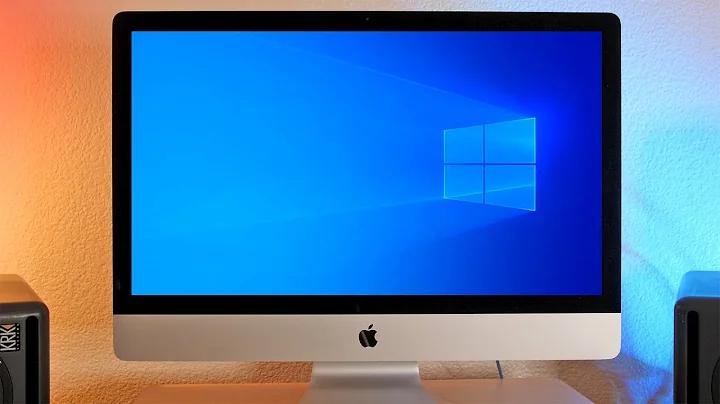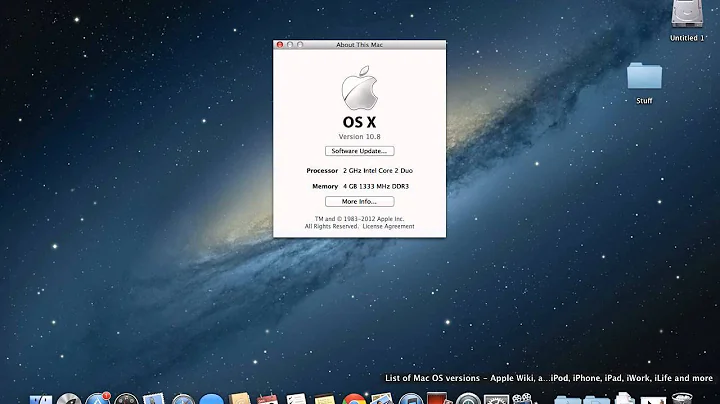How to identify which process is running which window in Mac OS X?
Solution 1
I've used this Python 2 script. It isn't foolproof, but it works pretty well for me.
Here's a summary of what it does: It uses CGWindowListCopyWindowInfo, which is imported from Quartz, to collect window info from the system, then asks the user to move the desired window, then collects window info again, and shows info for the ones that changed. The info dumped includes the process ID, as kCGWindowOwnerPID.
Here is the code:
#!/usr/bin/env python
import time
from Quartz import CGWindowListCopyWindowInfo, kCGWindowListExcludeDesktopElements, kCGNullWindowID
from Foundation import NSSet, NSMutableSet
wl1 = CGWindowListCopyWindowInfo(kCGWindowListExcludeDesktopElements, kCGNullWindowID)
print 'Move target window'
time.sleep(5)
wl2 = CGWindowListCopyWindowInfo(kCGWindowListExcludeDesktopElements, kCGNullWindowID)
w = NSMutableSet.setWithArray_(wl1)
w.minusSet_(NSSet.setWithArray_(wl2))
print '\nList of windows that moved:'
print w
print '\n'
The script prints information for the window that changed position within a 5 second interval. So the output looks like this:
List of windows that moved:
{(
{
kCGWindowAlpha = 1;
kCGWindowBounds = {
Height = 217;
Width = 420;
X = 828;
Y = 213;
};
kCGWindowIsOnscreen = 1;
kCGWindowLayer = 8;
kCGWindowMemoryUsage = 406420;
kCGWindowName = "";
kCGWindowNumber = 77;
kCGWindowOwnerName = UserNotificationCenter;
kCGWindowOwnerPID = 481;
kCGWindowSharingState = 1;
kCGWindowStoreType = 2;
}
)}
Solution 2
I made a tool named lswin
$ python lswin.py
PID WinID x,y,w,h [Title] SubTitle
------- ----- --------------------- -------------------------------------------
169 1956 {0,-38,1280,25 } [Window Server] Backstop Menubar
169 1955 {0,-60,1280,22 } [Window Server] Menubar
169 396 {0,-38,1280,25 } [Window Server] Backstop Menubar
169 395 {0,-60,1280,22 } [Window Server] Menubar
169 6 {0,0,0,0 } [Window Server] Cursor
169 4 {0,22,1280,25 } [Window Server] Backstop Menubar
169 3 {0,0,1280,22 } [Window Server] Menubar
169 2 {0,0,1280,800 } [Window Server] Desktop
262 404 {0,-38,1280,38 } [Google Chrome]
262 393 {0,0,1280,800 } [Google Chrome]
262 380 {100,100,1,1 } [Google Chrome] Focus Proxy
... ...
Then you can use grep to find your window's pid.
Here is the source code of the script:
#!/usr/bin/env python
import Quartz
#wl = Quartz.CGWindowListCopyWindowInfo( Quartz.kCGWindowListOptionOnScreenOnly | Quartz.kCGWindowListExcludeDesktopElements, Quartz.kCGNullWindowID)
wl = Quartz.CGWindowListCopyWindowInfo( Quartz.kCGWindowListOptionAll, Quartz.kCGNullWindowID)
wl = sorted(wl, key=lambda k: k.valueForKey_('kCGWindowOwnerPID'))
#print wl
print 'PID'.rjust(7) + ' ' + 'WinID'.rjust(5) + ' ' + 'x,y,w,h'.ljust(21) + ' ' + '\t[Title] SubTitle'
print '-'.rjust(7,'-') + ' ' + '-'.rjust(5,'-') + ' ' + '-'.ljust(21,'-') + ' ' + '\t-------------------------------------------'
for v in wl:
print ( \
str(v.valueForKey_('kCGWindowOwnerPID') or '?').rjust(7) + \
' ' + str(v.valueForKey_('kCGWindowNumber') or '?').rjust(5) + \
' {' + ('' if v.valueForKey_('kCGWindowBounds') is None else \
( \
str(int(v.valueForKey_('kCGWindowBounds').valueForKey_('X'))) + ',' + \
str(int(v.valueForKey_('kCGWindowBounds').valueForKey_('Y'))) + ',' + \
str(int(v.valueForKey_('kCGWindowBounds').valueForKey_('Width'))) + ',' + \
str(int(v.valueForKey_('kCGWindowBounds').valueForKey_('Height'))) \
) \
).ljust(21) + \
'}' + \
'\t[' + ((v.valueForKey_('kCGWindowOwnerName') or '') + ']') + \
('' if v.valueForKey_('kCGWindowName') is None else (' ' + v.valueForKey_('kCGWindowName') or '')) \
).encode('utf8')
Solution 3
@kenorb I combined your 2 versions of the script, basically it works like the first one, showing difference but formatting is from the second. Also if window is not on the screen - it's not being printed, otherwise it gives too much garbage
import Quartz
import time
from Foundation import NSSet, NSMutableSet
def transformWindowData(data):
list1 = []
for v in data:
if not v.valueForKey_('kCGWindowIsOnscreen'):
continue
row = ( \
str(v.valueForKey_('kCGWindowOwnerPID') or '?').rjust(7) + \
' ' + str(v.valueForKey_('kCGWindowNumber') or '?').rjust(5) + \
' {' + ('' if v.valueForKey_('kCGWindowBounds') is None else \
( \
str(int(v.valueForKey_('kCGWindowBounds').valueForKey_('X'))) + ',' + \
str(int(v.valueForKey_('kCGWindowBounds').valueForKey_('Y'))) + ',' + \
str(int(v.valueForKey_('kCGWindowBounds').valueForKey_('Width'))) + ',' + \
str(int(v.valueForKey_('kCGWindowBounds').valueForKey_('Height'))) \
) \
).ljust(21) + \
'}' + \
'\t[' + ((v.valueForKey_('kCGWindowOwnerName') or '') + ']') + \
('' if v.valueForKey_('kCGWindowName') is None else (' ' + v.valueForKey_('kCGWindowName') or '')) \
).encode('utf8')
list1.append(row)
return list1;
def printBeautifully(dataSet):
print 'PID'.rjust(7) + ' ' + 'WinID'.rjust(5) + ' ' + 'x,y,w,h'.ljust(21) + ' ' + '\t[Title] SubTitle'
print '-'.rjust(7,'-') + ' ' + '-'.rjust(5,'-') + ' ' + '-'.ljust(21,'-') + ' ' + '\t-------------------------------------------'
# print textList1
for v in dataSet:
print v;
#grab initial set
wl = Quartz.CGWindowListCopyWindowInfo( Quartz.kCGWindowListOptionAll, Quartz.kCGNullWindowID)
wl = sorted(wl, key=lambda k: k.valueForKey_('kCGWindowOwnerPID'))
#convert into readable format
textList1 = transformWindowData(wl);
#print everything we have on the screen
print 'all windows:'
printBeautifully(textList1)
print 'Move target window'
time.sleep(5)
#grab window data the second time
wl2 = Quartz.CGWindowListCopyWindowInfo(Quartz.kCGWindowListOptionAll, Quartz.kCGNullWindowID)
textList2 = transformWindowData(wl2)
#check the difference
w = NSMutableSet.setWithArray_(textList1)
w.minusSet_(NSSet.setWithArray_(textList2))
#print the difference
printBeautifully(w)
Solution 4
There's a direct user-friendly OS-native tool for inspecting each window which provide comprehensive information in addition to related process, such as originating code hierarchy : it's found under Xcode Developer Tools, and called Accessibility Inspector
Solution 5
You can use the Automator.app for this:
- Start Automator (in spotlight type
Automator.app+ Enter) - Create a new workflow.
- On the menu select Workflow > Record (or click the 🔴 [Record] button on the toolbar).
- Interact with the window you wish to inspect and then click the ⬛️ [Stop] button in the recording toolbar when done. (❗️ If the system prompts you about missing accessibility access then grant it in System Settings)
- Drag the recorded steps of interest from the Watch Me Do section to the empty panel below (a plus button will appear during drag). HINT: You can also select all steps and drag them all together in order to create a single script.
- Inspect the generated AppleScript to get the details you need.
NOTE: You can use this method to generate AppleScript code for locating windows, dialogs, setting text, clicking buttons, etc.
Here is an example video for recording mouse actions (ignore the last part which is plug about a 3rd party app).
Related videos on Youtube
Nacho Cougil
Updated on September 18, 2022Comments
-
 Nacho Cougil over 1 year
Nacho Cougil over 1 yearI’d like to know if it is possible to identify which process is responsible for creating/managing a window in Mac OS X.
For example, when multiple instances of an application are started, how can I get the process ID (PID) corresponding to one specific window? Or if there is a modal dialog window without a title, how can I get the PID of its owner?
I know in Windows it is possible using the Sysinternals Suite tool that provides a way to search for a library that is running with some data.
I’m looking for a mechanism similar to the one that appears in this blogpost.
In this case, using Sysinternals Suite (and Process Explorer), they found which DLL/program was using the webcam by searching for a DLL or substring (in this case, using the physical name of the device).
So is there any mechanism or program, or do you have any idea about how to search for something similar for Mac OS X? How I can identify which process has launched a window?
-
 Admin about 9 years“…which process is showing which window…” This is confusing when compared to your Windows example of “…which DLL/program was using the webcam by searching for a DLL or substring.” Can you please edit your question to clarify.
Admin about 9 years“…which process is showing which window…” This is confusing when compared to your Windows example of “…which DLL/program was using the webcam by searching for a DLL or substring.” Can you please edit your question to clarify. -
 Admin about 9 yearsSome processes are running without any windows, and perhaps even without a controlling terminal.
Admin about 9 yearsSome processes are running without any windows, and perhaps even without a controlling terminal.
-
-
C_K over 8 years@echo on - I'm not sure how to apply what that site shows, could you elaborate?
-
Michael Fox over 6 yearsFantastic. One step closer to xkill for Mac!
-
 Mark Ebbert over 6 yearsLooks like the link to the python script is dead. I believe I found the same post on a new blog site here: cadebaba.blogspot.com/2014/04/…
Mark Ebbert over 6 yearsLooks like the link to the python script is dead. I believe I found the same post on a new blog site here: cadebaba.blogspot.com/2014/04/… -
Hay over 6 yearsWorks perfectly. Thanks for sharing @osexp2003!
-
 Samvel Avanesov over 6 yearsThis is an amazing script. It helped my find nasty software which I couldn't identify.
Samvel Avanesov over 6 yearsThis is an amazing script. It helped my find nasty software which I couldn't identify. -
CupawnTae over 5 yearswith a little bit of
pip install pyobjc-framework-Quartz -
 DaveBurns over 5 yearsNote that the script doesn't work 100% with multi-monitor set ups. If you run this in a terminal on one screen and then move the window on another screen, you will see many windows listed in the diff. All of them seem to be system windows and icons in the menu bar, etc. Best to move your terminal and the mystery window to the same screen before running.
DaveBurns over 5 yearsNote that the script doesn't work 100% with multi-monitor set ups. If you run this in a terminal on one screen and then move the window on another screen, you will see many windows listed in the diff. All of them seem to be system windows and icons in the menu bar, etc. Best to move your terminal and the mystery window to the same screen before running. -
 Jerry Krinock over 4 yearsNICE!! This is indeed the clean, correct way to identify and remove malware which pops up alert windows. Much better than installing and running an antivirus program which, who knows, may itself be malware.
Jerry Krinock over 4 yearsNICE!! This is indeed the clean, correct way to identify and remove malware which pops up alert windows. Much better than installing and running an antivirus program which, who knows, may itself be malware. -
moof2k about 4 yearsThis is great. Thanks for sharing!
-
 mike over 3 yearsSpotlight "Accessibility Inspector" took me right to it. Crosshairs for selecting window of interest. Thank you!!
mike over 3 yearsSpotlight "Accessibility Inspector" took me right to it. Crosshairs for selecting window of interest. Thank you!! -
DarkDust over 2 yearsThere's a pull request to bring the code to Python 3. Raw file from the PR can be found here, to install the dependency use
pip3 install pyobjc-framework-Quartz -
 Admin almost 2 yearsYou will need to install Quartz:
Admin almost 2 yearsYou will need to install Quartz:pip install pyobjc-framework-Quartz.







